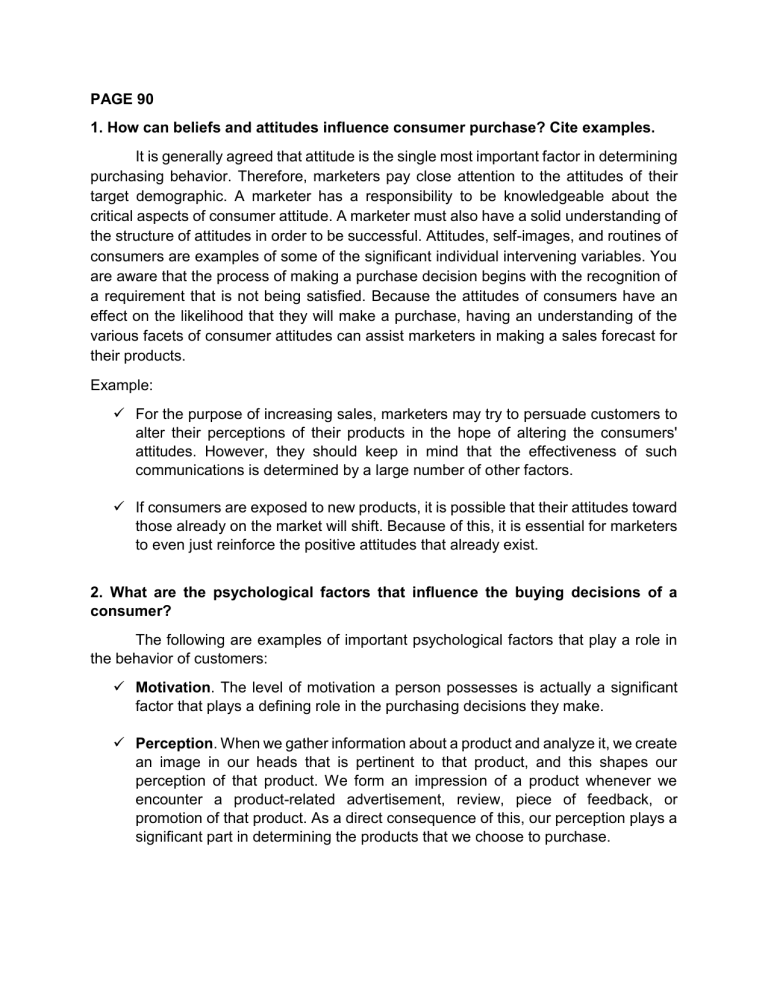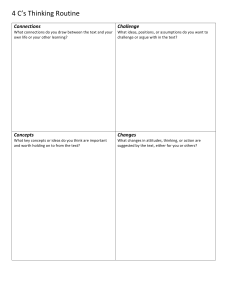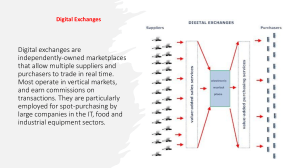
PAGE 90 1. How can beliefs and attitudes influence consumer purchase? Cite examples. It is generally agreed that attitude is the single most important factor in determining purchasing behavior. Therefore, marketers pay close attention to the attitudes of their target demographic. A marketer has a responsibility to be knowledgeable about the critical aspects of consumer attitude. A marketer must also have a solid understanding of the structure of attitudes in order to be successful. Attitudes, self-images, and routines of consumers are examples of some of the significant individual intervening variables. You are aware that the process of making a purchase decision begins with the recognition of a requirement that is not being satisfied. Because the attitudes of consumers have an effect on the likelihood that they will make a purchase, having an understanding of the various facets of consumer attitudes can assist marketers in making a sales forecast for their products. Example: For the purpose of increasing sales, marketers may try to persuade customers to alter their perceptions of their products in the hope of altering the consumers' attitudes. However, they should keep in mind that the effectiveness of such communications is determined by a large number of other factors. If consumers are exposed to new products, it is possible that their attitudes toward those already on the market will shift. Because of this, it is essential for marketers to even just reinforce the positive attitudes that already exist. 2. What are the psychological factors that influence the buying decisions of a consumer? The following are examples of important psychological factors that play a role in the behavior of customers: Motivation. The level of motivation a person possesses is actually a significant factor that plays a defining role in the purchasing decisions they make. Perception. When we gather information about a product and analyze it, we create an image in our heads that is pertinent to that product, and this shapes our perception of that product. We form an impression of a product whenever we encounter a product-related advertisement, review, piece of feedback, or promotion of that product. As a direct consequence of this, our perception plays a significant part in determining the products that we choose to purchase. Attitudes and Beliefs. Our mindset and the things that we believe influence not only how we act in relation to a product but also play an important part in the formation of the product's brand image. Therefore, in order for marketers to effectively design their marketing campaigns, it is helpful for them to understand the attitudes and beliefs held by consumers. Learning. When we buy something, we gain more experience and therefore a more in-depth understanding of what it is we bought. This learning is primarily dependent on our previous experiences, our existing knowledge, and our existing skills. This learning can either be cognitive or conditional, depending on the circumstances. Ask your parents about how they decided on the purchase of your family's first house. What are the things they considered? What stages in the consumer adoption process did they go through? My parents advised me that the home-buying process can become increasingly overwhelming as more factors are taken into consideration. This information came to light while I was thinking about the factors involved. Their mental health is of the utmost importance throughout the entirety of the home-buying process. The location is one of the most important aspects that they take into consideration. They give special attention to the neighborhood, and one of their primary concerns is determining whether or not the property provides convenient access to your place of employment. Think about where the house is situated in relation to the rest of the neighborhood. In addition, the size of the lot that the house is situated on will have an effect on a variety of facets of the uses and potential of their home. PAGE 84 What are the things to consider in the information search? We frequently base our decisions to purchase a product on the recommendations of others. The act of purchasing is frequently influenced by opinions. It's possible that a good friend will recommend a new restaurant to us, or that you might decide to give a new hair product that has received a lot of positive feedback a shot. The search for information is something that consumers do both internally and externally. When conducting an internal search, the consumer looks to his or her own memory to recall potential alternatives. Consumers are more likely to conduct an external search when the product in question requires a high level of involvement. A consumer, before making a large purchase like purchasing a car, for instance, may seek the advice of their friends, read reviews in Consumer Reports, consult several websites, and go to several different dealerships. Therefore, businesses that manufacture goods that are predominantly chosen as a result of an external search have an obligation to make the relevant information readily available to consumers in need, be it in the form of brochures, websites, or media coverage. Bargaining of Suppliers The Coca-Cola suppliers' ability to bargain for better prices is limited. This is the case due to the fact that Coca-Cola has a large pool of potential suppliers and relatively low costs associated with switching. Although Coca-Cola can easily switch from one supplier to another, no other supplier can switch away from Coca-Cola in the same straightforward manner. That could result in financial hardship for any one of the vendors. Although there are a number of suppliers, the size of each individual supplier is either relatively small or only somewhat substantial. In addition, the majority of its suppliers do not have much of a chance of engaging in forwarding integration. Even if there are no other raw materials that can be used in place of sugar, there is still a large pool of potential suppliers. As a result, the following are the primary aspects that have been brought to light in relation to the bargaining power of suppliers: Numerous businesses that provide the service the size of individual suppliers ranges from relatively small to moderately large. Integration in the front end is challenging for the suppliers. There is not much of a premium for switching to Coca-Cola.





